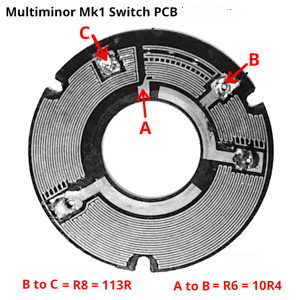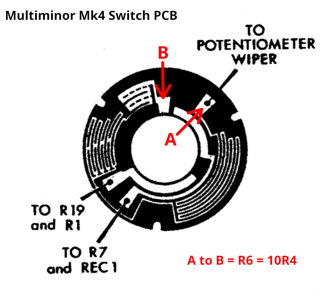
Mk1

MK4 (with meter movement from an earlier model)
serial numbers 017542 and 71044
The AVO Multiminor was a development of the original AVO multimeter which started life back in 1923, and although it was initially a DC-only instrument many of its features remained almost unaltered right through to the meter shown here. Though known for their Avometer general purpose multimeter's, they made a wide range of test gear including valve testers, oscillators and light meters. You will find more information here about these instruments and other similar models. AVO also produced a range of the smaller multimeters which are described here.

Mk1

MK4 (with meter movement from an earlier model)
AVO Multiminor This sturdy multi-range test meter is
remarkable for the wide range of test facilities which have
been incorporated. Full advantage has been taken of printed resistor
techniques to produce a compact instrument of low weight. It features
composite printed resistors and robust range switch similar to that
used in the full size AvoMeters. Eighteen fixed silver plated contacts
embedded in a ring of high-grade moulding material are swept by a
double contact rotor arm. Meter movement is enclosed to give protection
against the infiltration of dust.
19 Ranges� Single Knob Control:
7 D.C. Voltage Ranges: 0-1,000 V. 5 A.C. Voltage Ranges: 0-1,000 V.
5 D.C. Current Ranges: O-IA.
2 Resistance Ranges: 0-20,0000ohm 0-2Mohm
Sensitivity:
10,000 ohms/V on D.C. voltage ranges.
1,000 ohms/V on A.C. voltage ranges.
Accuracy:
3% of full scale value on D.C.
4% of full scale value on A.C

MK1 inside

MK4 inside
I purchased the Mk1 meter in 2017 at a charity boot sale, it came in
a leather case and had a pair of perished leads. It seemed fairly clean
and cost me �5. I found that the meter deflected when a 1.5 volt
battery was applied to the sockets but there was clearly something
amiss since the 10volt range and above did not work. With some
difficulty I managed to get the meter out of the metal case and I saw
that the printed circuit shunt for the 1Amp range had melted in two
places and that the wiper contacts on the switch were
discoloured perhaps indicating that the instrument had been subjected
to an over voltage or current at some time. A small blob of solder
cured the first problem and the meter then indicated current fairly
accurately on all DC ranges. The voltage problem was more complex. The
range switch which was very stiff to turn was not making contact on the
10 Volt contact and both sections of the rectifier were open circuit.
Connections to the printed circuit disk and a couple of others were
unsoldered and after removing the centre screw wiper contact and
Bakelite disk it could be removed [3 screws] to reveal the switch
contacts see below.



Range switch contacts
[after cleaning] and printed
resistors which form part of the Ohms ranges.
The 113 ohm resistor (R8) on the Mk4
model is a conventional resistor.
Thanks to Alan Griffiths for providing
these much clearer diagrams of the printed resistors.
The knob was then withdrawn taking care to observe that there is a ball bearing situated in a small recess which bears upon the underside. The discoloured wipers were removed and cleaned with hydrochloric acid and wire wool. After lubricating and putting it all back together the switch worked smoothly and made contact correctly. The next thing was to select two germanium diodes and wire them in place of the faulty rectifier. The engravings on the front panel were refilled with off white paint.


Case
and leads for the MK1
I purchased the Mk4 meter on eBay in 2014 as nobody else seemed to want it. It was scruffy but the movement worked and the meter appeared to give correct readings on the AC and DC voltage scales and the pointer tended to stick. The outside is discoloured presumably from light damage as the interior is very much lighter. From its construction and I believed this to be a Mk 4 instrument with a meter movement from an earlier model (Mk4 meters are labelled as such on the scale plate).The serial number and the date code on the blue resistor indicate that it was made in 1971. When I removed the movement to find the cause of the pointer sticking I found that it was marked 8/74. The ohms ranges worked once the battery connections were cleaned. The engravings on the front panel were refilled with black paint. I believe that this may be one of the last of this model as the Mk5 version became available in the early 1970"s

Click here for instruction manual
Click here for service instructions
Battery A single AA 1.5 volt cell
What is it worth? Mine cost me �5, don't pay more than �10
unless it has leads and leather case.
For further information have a look at my pages on similar
AVOmeters here

